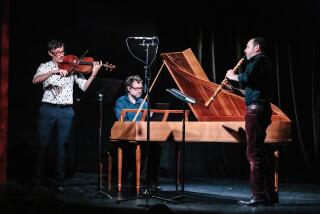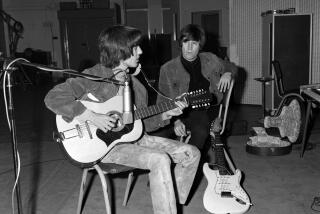Harpsichord Craftsmen Really Go for Baroque
Across the street from a car wash and the enormous, concrete garage of the Eagle Rock Plaza, a little bit of the Baroque Age flourishes.
The car radios outside may be blasting the Beastie Boys’ rap music, but the delicate and complicated sounds of Bach and Handel fill the air inside the Harpsichord Center.
There, in a small office building at the corner of West Broadway and Sumner Avenue near the border of Eagle Rock and Glendale, William Neil Roberts and Anthony Brazier assemble, decorate and tune reproductions of harpsichords, which were the rage of 17th- and 18th-Century Europe.
Roberts and Brazier are missionary-businessmen, plucking the strings of praise for the antique-styled harpsichord and its music. They are, admittedly, dealing in a market for very select tastes and pocketbooks.
To its lovers, a harpsichord sounds elegant and cerebral; but to some modern ears, it can be twangy and, because there is no way to change volume, repetitive. And the price tag, ranging from $3,400 to $17,000, can be daunting.
Yet somehow, with subsidies from teaching and performing, the partners have kept their business alive for nine years. They say they have built and sold about 60 harpsichords and other early keyboard instruments to individuals and schools around Southern California and the world.
Along the way, they have been criticized for being part of a worldwide network of builders viewed as a threat by outside artisans. They have also earned praise from musicians and teachers for helping to keep Baroque music alive in Los Angeles.
“We have not yet sold one to someone who is not interested in using it as a musical instrument. In other words, we’ve never sold one to someone as a piece of furniture. Yes, it is supposed to be as much a delight to eye as to the ear, but the visual is only half of it,” boasts Roberts, who is 57 and has recorded eight albums of harpsichord music, including two albums of Scott Joplin rags.
Brazier, 35 and a professional flutist, said he loves the “transparency and expressiveness” of harpsichord music when it is played well. Playing the harpsichord, he explained, is a much less physical activity than playing the piano. Harpsichord keys have a shallow dip because the strings are plucked rather than, as in a piano, hammered. And there are no pedals.
“The harpsichord is a mind instrument, and it is a very simple instrument. But it is not an instrument for simple minds,” Brazier said recently while he was carefully painting blue scalloping on the spruce top of a Flemish-style model.
Roberts and Brazier are the Southern California agents for Zuckerman Harpsichords Inc. which, according to its owner, D. Jacques Way, is the largest harpsichord-building company in the world. Craftsmen at Zuckerman factories in Stonington, Conn., and Paris cut and mill most of the wooden parts for about 10 basic models and for custom designs.
A Zuckerman kit arrives at the Eagle Rock shop in about 300 pieces, in addition to hundreds of pins to hold the strings. It takes Roberts and Brazier about two months to assemble, string and paint each instrument, with special attention paid to the customer’s playing habits and the climate where the harpsichord will be kept.
Their work often includes gouging out the bottom of keys to achieve a balanced touch, shaving back the soundboard to improve the tone, carefully sanding the exterior and covering it with up to eights coats of paint and then elaborate patterns of painted flowers and birds. They divide the chores but work on one harpsichord at a time until the finishing touch: painting their logo, “Roberts & Brazier--Los Angeles.”
‘Develop a Sixth Sense’
“I like to keep all of my thoughts on the outcome of one instrument from the onset to the end,” Roberts said. “It sounds very mystical, I know. But when you are working with wood, you develop a sixth sense about it as long as you keep your mind on one instrument.”
Adds Brazier: “You can’t be in a hurry.”
The men keep five or six harpsichords and antique-style pianos to rent out and they sell unfinished Zuckerman kits to amateur builders. They both perform with the Los Angeles Baroque Players, a quartet completed with a viola and a violin. And, they run a concert series, which they moved this year from their shop to the ballroom of Castle Green, the elegant former hotel in Pasadena converted into an apartment building. The next concert, on April 24 at 8 p.m., features Karen Swietlik on an 18th Century-style fortepiano built by the Eagle Rock shop.
Back-Biting Business
The craft of Harpsichord building is one marked by backbiting and short-lived businesses because the sales volume is so limited, musicians and builders say. There are a handful of builders in the Los Angeles area, and some of them criticize the Eagle Rock men for not designing their own instruments and not cutting all their own parts. Critics claim the Zuckerman network is intent on killing off independent artisans.
“Paint by numbers” is how Jerome Prager of Hollywood described the Harpsichord Center’s work. Prager is admittedly emotional because, after 18 years of building harpsichords from scratch, he quit the business six months ago. “It has become virtually impossible to be an independent harpsichord maker,” he said. Yet, he added of the Eagle Rock shop: “Anyone building harpsichords is doing something good for society.”
Lower Prices
According to Robert Winter, a music professor and keyboard expert at UCLA, the Zuckerman connection allows Roberts and Brazier to sell well-made harpsichords and the smaller, boxy clavichords at lower prices than other builders. “They have put plucked instruments into many, many households which otherwise would not have been able to afford them,” said Winter.
“This is a city without a lot of continuity, and for Neil (Roberts) to have survived as long as he has is very, very impressive. And I don’t mean that in a Pollyannish sense,” he added.
Susanne Shapiro, a concert harpsichordist, agreed. “I admire both Neil and Tony for having begun the Harpsichord Center . . . . It is a cultural enrichment for Southern California.”
For his part, Roberts said he could carve all his own parts but that would allow him to build only one or two instruments a year and keep him from learning about historical-research and technological advances.
Lower Rents in Eagle Rock
“Some people’s ego makes them feel they have to build from scratch. I’ve never felt that compulsion or need. I’m just interested in a good instrument,” said Roberts. He resists the temptation to move to a higher-profile location on the Westside, he said, because of the lower rents in Eagle Rock and the quieter atmosphere that allows more concentration on his work.
Much of the old art of building harpsichords was lost until about 25 years ago. The harpsichord, associated with aristocracy, fell into disfavor after the French Revolution. About the same time, the modern piano was developed and was better suited to the Romantic music of the 19th Century. Not until after World War I was there a revival in harpsichord building, albeit of large, modern-style ones that resembled pianos.
However, in the 1960s, harpsichordists and builders in New England began to study and reproduce the 17th- and 18th-Century instruments of Italy, France and the Low Countries. The revival spread.
To be sure, there are modern touches. Power tools are used and some parts are plastic, like the jack and plectrum, which pluck the strings. For a higher price, Roberts and Brazier offer wooden pegs and the traditional, crow quill plectra.
But, short of going to museums or spending a fortune on real antiques, building a reproduction is the best way to ensure that you will hear so-called Early Music as it was intended to be played, Roberts explained.
“I love the clearness of it,” he said, his fingers almost automatically tapping out a delicate phrase of J. S. Bach.
More to Read
The biggest entertainment stories
Get our big stories about Hollywood, film, television, music, arts, culture and more right in your inbox as soon as they publish.
You may occasionally receive promotional content from the Los Angeles Times.











